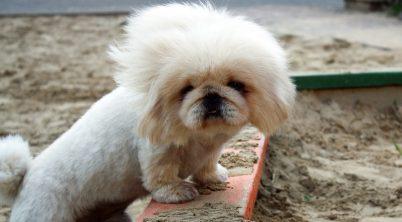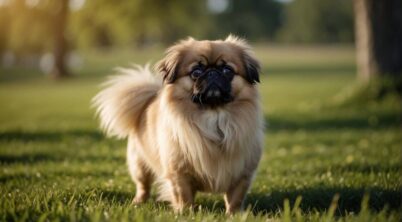The Pekingese is a toy dog breed characterized by its distinctive lion-like image, confidence, and compact form. With their flowing mane and bold disposition, they present an air of regality that belies their small size. This breed typically weighs in between 7 and 14 pounds, reflecting their role throughout history as cherished companions of Chinese nobility. Despite their modest stature, standing only 6 to 9 inches at the shoulder, Pekingese dogs carry themselves with a dignified poise that demands attention.
Understanding the average measurements of Pekingese dogs is crucial for prospective owners, breeders, and those who wish to ensure the well-being of these animals. The breed’s size is a result of careful selective breeding, which sought to create a portable yet noble companion. While their measurements might be small, a Pekingese’s body is surprisingly stocky and solid beneath their abundant coat, with weight and height variations that correspond to the individual dog’s genetics and lifestyle.
When discussing the size of Pekingese, it’s necessary to note that there can be variation within the breed. All colors and patterns are acceptable within the breed standard, which prioritizes overall balance and proportion in conformation. As dogs of this breed mature, it is normal for there to be fluctuations in their dimensions until they reach their full size, which typically occurs by the age of 1 to 1 and a half years. Prospective and current owners should pay close attention to these measurements to ensure proper nutrition and care, as well as to make informed decisions when participating in events that value breed standards.
Table of Contents
Average Pekingese Measurements
In considering the average measurements of a Pekingese, it is essential to note that this toy breed exhibits a compact body, a distinct feature that reflects its noble origins and impressive character. The Pekingese has a typically robust stature when considering height, length, and weight.
Height
The average height for a Pekingese lies between 6 to 9 inches (15-23 cm) at the withers, which is the highest part of the back at the base of the neck.
Length
A Pekingese’s body length from the chest to the base of the tail usually is in greater proportion compared to the height, presenting a slightly elongated appearance.
Weight
An adult Pekingese generally weighs in the range of 7 to 14 pounds (3.17-6.35 kg), with the precise weight depending on factors such as diet, exercise, and overall health.
Pekingese Profile

The Pekingese is a small-sized companion dog known for its regal and distinctive appearance, reflecting its storied past in Ancient China. This breed exhibits a range of traits that encompass both its physicality and personality, important for potential owners to understand.
Growth and Development
Age: Pekingese puppies undergo various stages of growth before they reach their adult size. By 6 months, Pekingese typically reach about half their adult weight. Full adult size is generally achieved by 12 to 18 months, although growth may continue slightly beyond this period.
- Pekingese Growth Chart: (For illustrative purposes only)Age (Months)Weight (Pounds)33-4 lbs65-7 lbs128-14 lbs
Genetics and Environment: Both factors play crucial roles in the growth and development of a Pekingese. Appropriate nutrition, controlled feeding to prevent obesity, and regular check-ups with a veterinarian can aid in a healthy development.
Breed Standards
Appearance: This breed is characterized by a stocky, compact body, a flat face, and a noticeable mane, resembling a lion’s profile.
Height and Weight: The standard weight range for Pekingese, as outlined by the Pekingese Club of America, is between 7 and 14 pounds. The ideal height, measured at the withers, is between 6 and 9 inches.
Gender Differences: Generally, male Pekingeses may be slightly larger, affecting the weight and height. There can be a slight variance in size between male and female Pekingeses within the breed’s standard measurements.
Size Classifications
- Toy Breed: Pekingese belong to the toy group, reflecting their small size and companion role.
- Sleeve Pekingese: A smaller version, known as “Sleeve Pekingese,” is a term used historically for Pekingese that were small enough to fit into the sleeves of garments worn by members of the Chinese Imperial family.
- Stockiness: Despite their small stature, Pekingeses are stocky with a rolling gait that is unique to the breed.
These classifications are vital in understanding the expected size and characteristics of the Pekingese, which in turn influences their care, ranging from grooming to nutrition needs.








